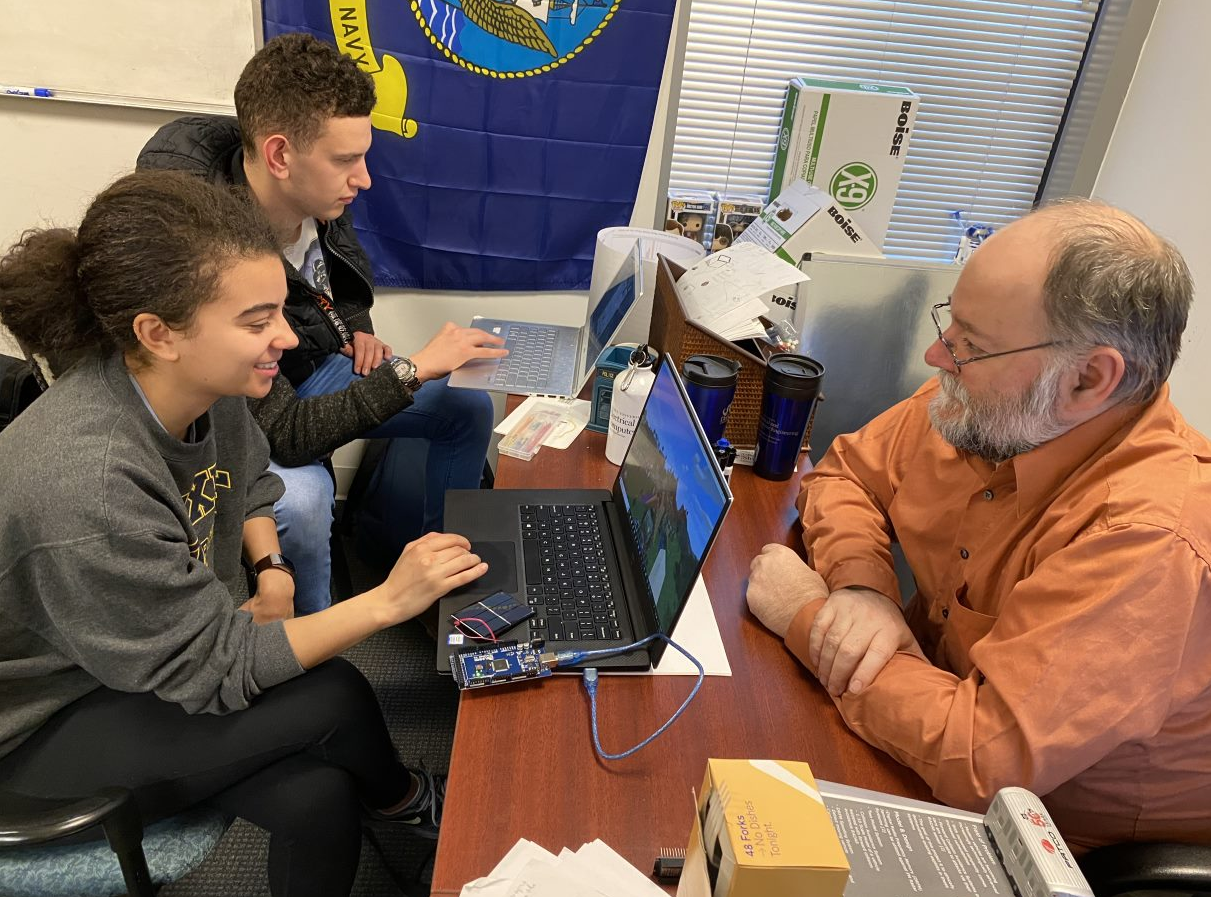 ECE seniors Madeline Cook and Anton Peschansky discuss their senior design project with Dr. Chris Peters
ECE seniors Madeline Cook and Anton Peschansky discuss their senior design project with Dr. Chris Peters
How do you make an abstract topic like renewable energy interesting to young students? This senior design group decided to try to meet the students where they already are: the hit video game Minecraft.
This year, ECE seniors Madeline Cook, Anton Peschansky, and Benjamin Teperov joined together under the advisement of Dr. Chris Peters, to, as the team put it in their winter term poster presentation, "create a fun and interactive renewable energy learning module in Minecraft for students in grades 6-12.” For those unfamiliar, Minecraft is the best-selling video game of all time, an online “sandbox” game where players can mine resources, build structures, and interact with other players in a massive open world.
“Renewable energy education is not prioritized and often inaccessible,” says the team in the winter term progress report. “Being exposed to new energy technology in a cohesive and comprehensive way early can spark interest in STEM/power engineering” among younger students. Additional constraints include budgetary and expertise limits within K-12 schools, a belief that renewable energy technologies are not easily demonstrable and that theories of renewable technologies are not attention-grabbing for students. The team’s proposed solution is to “create a fun, interactive module” combining an environment familiar to make young students—in this case, Minecraft—“with hardware and power theory to teach middle- through high-school students about renewable energy.

Hardware/software configuration.
For their senior design project, this group provides users “with a pre-made world in Minecraft that already contains structures such as…buildings and a solar farm with solar panels,” all features users can edit at will. Users are provided Minecraft books and other resources about renewable energy types.
“The best part about this project is that it’s highly relevant,” said Cook. “We are electrical and computer engineering students have an interest in power and software/hardware integration, but that passion [may not be] widespread outside of engineering. We have found, however, that a passionate interest in Minecraft is present.”
The team developed modifications to Minecraft using Mcreator. Mcreator is a mod-making software used to augment Minecraft to simulate realistic power systems. MinecraftLink then allows for the real-time data to be sent from an attached, miniature solar panel and miniature wind turbine to the Minecraft game. The solar panel and wind turbine are used to model solar and wind energy. Users then follow a role-playing game (RPG)-like structure developed by the senior design team, which they created by adding Non-Playable Characters, brick paths, and building boundaries.

Book and quill learning materials.
For the remaining third of the senior design sequence, Cook, Peschansky, and Teperov plan to improve their current solar module by testing it with students in their target demographic and reviewing it with renewable energy educators at the high school and university levels. They also plan on implementing wireless data transmission in their solar panel using Arduino’s wifi capabilities.
“It has been extremely rewarding to see the faces of so many light up with intrigue as we explain our project,” shared Cook. “Additionally, it has been reassuring that our key goal of capturing interest has been fulfilled.”
One of the key objectives of Drexel Engineering’s senior design sequence is to cultivate skills that graduates can take forward into their careers, including “budgeting, documentation, writing reports, and project management,” said Cook, as well as “tangible engineering skills such as Arduino and Java programming, implementation of wi-fi protocols, and energy modeling.”